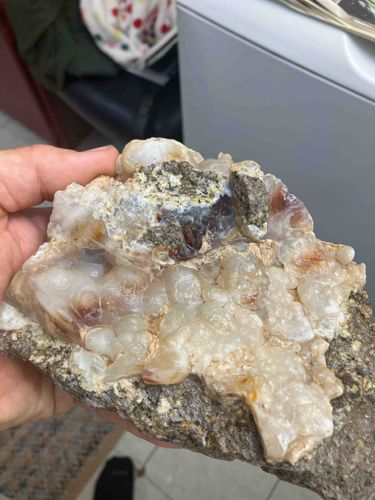
Botryoidal Chalcedony Mineral Specimen
A natural mineral specimen exhibiting a botryoidal formation of chalcedony, likely agate or common opal, on a matrix of host rock. The botryoidal growths appear as rounded, grape-like clusters, with a translucent to opaque appearance. The colors visible in the chalcedony range from milky white and off-white to light beige, with some reddish-brown staining and darker inclusions within the botryoidal structures. The host rock matrix is a darker, rough texture, showing earth tones of brown and gray with visible mineral grains and possible crystalline structures embedded. There are areas on the matrix that appear fractured or broken, exposing the internal structure of the rock and the attachment point of the mineral formation. The overall condition appears to be natural state, with no obvious signs of polishing or artificial modification. The size and weight are not specifically discernible from the image, but it appears to be handheld. The quality indicators suggest a natural, unprocessed state, valuable for collectors of raw mineral specimens. The formation is a result of natural geological processes, likely formed in a vein or cavity within the host rock over significant time periods.
AI-Generated Appraisal Disclaimer
Estimated Value
$75 - $150
Basic Information
Category
Mineral Specimen
Appraised On
November 28, 2025
Estimated Value
$75 - $150
Item Description
A natural mineral specimen exhibiting a botryoidal formation of chalcedony, likely agate or common opal, on a matrix of host rock. The botryoidal growths appear as rounded, grape-like clusters, with a translucent to opaque appearance. The colors visible in the chalcedony range from milky white and off-white to light beige, with some reddish-brown staining and darker inclusions within the botryoidal structures. The host rock matrix is a darker, rough texture, showing earth tones of brown and gray with visible mineral grains and possible crystalline structures embedded. There are areas on the matrix that appear fractured or broken, exposing the internal structure of the rock and the attachment point of the mineral formation. The overall condition appears to be natural state, with no obvious signs of polishing or artificial modification. The size and weight are not specifically discernible from the image, but it appears to be handheld. The quality indicators suggest a natural, unprocessed state, valuable for collectors of raw mineral specimens. The formation is a result of natural geological processes, likely formed in a vein or cavity within the host rock over significant time periods.
Related Tags
Get Your Items Appraised
Instant estimates of your treasures with AI-powered instant appraisals